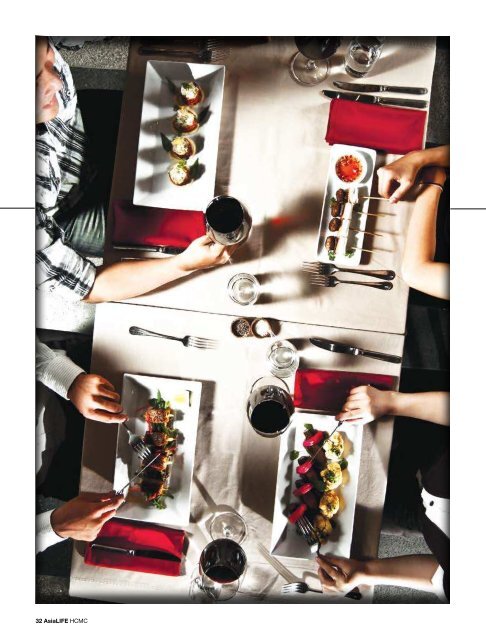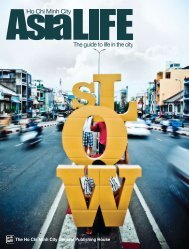transition - AsiaLIFE Magazine
transition - AsiaLIFE Magazine
transition - AsiaLIFE Magazine
- No tags were found...
You also want an ePaper? Increase the reach of your titles
YUMPU automatically turns print PDFs into web optimized ePapers that Google loves.
Trying to define modern and fusioncuisine can be a tricky business.You’re bound to get as many differentanswers as people you ask.Is modern cooking the ‘molecular gastronomy’made famous by controversial Spanishchef Ferran Adria? Although, white garlic andalmond sorbet, tobacco-flavoured blackberrycrushed ice or mini parmesan ice creamsandwich with trout egg tempura is going wellbeyond just ‘modernization’.Most often, the term ‘modern’ is applied tostandard dishes that have been updated ormodified in some fashion.Likewise, the utterance of the word ‘fusion’can be enough to put a fright into seriousfood lovers given some of the mismatches thetrend has produced. Generally it is recognizedas combining ingredients or techniques fromdifferent culinary traditions to form somethingentirely unique.Getting a handle on these terms becomeseven more challenging when you try to applythem to Vietnamese cuisine. The culinarytraditions here are strong, and this vigor isnaturally resistant to change or amalgamation.To put it more bluntly: people want the traditionalfood they have grown up with and thathas been passed down through generations(which is understandable, given it’s generallyso fresh and healthy).This is the essential challenge when tryingto put a modern take on Vietnamese food,and even the best can find it difficult to strikethe right balance. Nguyen Duc Bien from XuRestaurant Lounge is an industry veteranhaving learnt his trade in Australia where hemanaged and owned restaurants. He madehis first trip to Vietnam at age 18 and returnedfor the third time three years ago to open hislatest restaurant.The goal was to create a truly internationalrestaurant, a place you could walk into andbe anywhere in the world. Yet by Bien’s ownadmission they, “set the bar too high” whendesigning their initial menu.“Overseas critics loved us and we got greatreviews,” explains Bien. However, after thisinitial honeymoon period of fascination withthe new restaurant on the block, things hitan impasse with the local clientele. It was alittle too cutting edge, a little too much of adeparture from traditional cuisine.“I think some people left a little bit confused,”Bien says.So changes were made to meet themarket. Dishes and concepts were altered tomake things more appealing to local diners.Individual servings were traded in for morefamily-friendly sharing options, and disheswere redesigned to align closer to tradition.The key, according to Bien, is to capturethe soul of Vietnamese food and then giveit a slight twist. “Don’t try too hard,” he saysis the secret for creating good fusion dishes.He should know, he lived through the fusioncraze in Australia in the 1990s where thingsdid not always work out as planned. “No oneunderstood how to fuse properly, people justthrew it all together.”An example Bien gives of what does workis the pork belly, which is very familiar to localdiners and often served with a type of cabbage.At Xu it is braised in coconut juice andserved with a sauerkraut-style pickled redcabbage and caramelized daikon.Another interesting combination on the Xumenu is the Vietnamese herb infused risotto.“Initially we were trying to make a pesto,” Bienexplains. With a little bit of experimentationand creativity, they came up with what hasbecome a consistently popular dish.New on the scene is Chris van der Kuil,chef at Flow. His focus is to do Europeanfood using almost exclusively Vietnameseingredients.“It is very important to cater to the Vietnamesecustomer, and there should be someelement in the dish that they recognize andhopefully like,” he says.A good example is the rouleau stuffed withbeef in a black olive sauce wrapped in rice paper.The dish is based on bo la lot, and aimsto have something familiar for everyone.“Once I explained the thinking behind it tomy staff they liked it a lot. It is mixed but notover the top,” van der Kuil says.“Vietnamese like it but recognize it as different,while expats see it as something Vietnamesebut when they bite in to it they recognizethe beef that their mother or grandmotherused to make.“It is that kind of mix that we are going for.”Less is more would seem to be theapproach when it comes to modernizingVietnamese culinary traditions, or incorporatinglocal ingredients and techniques into otherstyles. Progress in this area looks set to bedictated by the willingness of mainstream Vietnamto move out of its culinary comfort zone.Yet it is encouraging that there are innovatorsin HCM City’s culinary scene who arepushing the envelope, experimenting andeducating with their food.32 asialife HCMC asialife HCMC 33















